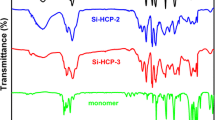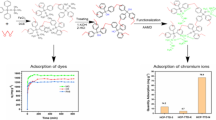Abstract
In this work, a series of hybrid porous hypercrosslinked polyanilines were successfully synthesized by polyaniline and octavinylsilsesquioxane (OVS) via the Friedel–Crafts alkylation reaction. Compared with N-alkylation reaction, the new synthetic approach circumvents some intractable problems, such as high reaction temperatures and pressures, tedious procedures and limited reactants. The resulting hybrid porous polyanilines had apparent surface areas in the range of 22 ± 5 to 461 ± 20 m2 g− 1, and total pore volumes in the range of 0.08–0.30 cm3 g− 1. The porosity of these polymers can be fine-tuned by varying the mass ratio of OVS to polyaniline. Gas sorption applications reveal that the CO2 adsorption capacity of HPANI-5 was 0.59 mmol g− 1 (2.60 wt%) at 298 K and 1.01 bar. Cr(VI) removal experiments reveal that HPANI-1 possessed the maximum Cr(VI) removal capacity at 308 K and pH 1 with an equilibrium adsorption capacity of 1230 ± 80 mg g− 1. The results suggested that the resulted hypercrosslinking polyanilines had potential to be used as adsorbents for CO2 uptake and Cr(VI) removal.








Similar content being viewed by others
References
V. Torres-Costa, R.J. Martín-Palma, Application of nanostructured porous silicon in the field of optics. A review. J. Mater. Sci. 45, 2823–2838 (2010)
J.S.M. Lee, M.E. Briggs, T. Hasell, A.I. Cooper, Hyperporous carbons from hypercrosslinked polymer. Adv. Mater. 28, 9804–9810 (2016)
D.C. Wu, F. Xu, B. Sun, R.W. Fu, H.K. He, K. Matyjaszewski, Design and preparation of porous polymers. Chem. Rev. 112, 3959–4015 (2012)
E.M. Gallego, M.T. Portilla, C. Paris, A. León-Escamilla, M. Boronat, M. Moliner, A. Corma, Ab initio” synthesis of zeolites for preestablished catalytic reactions. Science 355, 1051–1054 (2017)
T.A. Saleh, M. Naeemullah, A. Tuzen, Sari, Polyethylenimine modified activatedcarbon as novel magnetic adsorbent for the removal of uranium from aqueous solution. Chem. Eng. Res. Des. 117, 218–227 (2017)
A.V. assilakopoulou, V. Georgakilas, N. Vainos, I. Koutselas, Successful entrapment of carbon dots within flexible free-standing transparent mesoporous organic-inorganic silica hybrid films for photonic applications. J. Phys. Chem. Solids 103, 190–196 (2017)
T.R. Zhan, S.S. Lu, H.Q. Rong, W.G. Hou, H.N. Teng, Y.H. Wen, Metal-organic-framework-derived Co/nitrogen-dopedporous carbon composite as an effective oxygen reduction electrocatalyst. J. Mater. Sci. 53, 6774–6784 (2018)
Y. Wu, L.G. Li, W.Y. Yang, S.Y. Feng, H.Z. Liu, Hybrid nanoporous polystyrene derived from cubic octavinylsilsesquioxane and commercial polystyrene via the Friedel-Crafts reaction. RSC. Adv. 5, 12987–12993 (2015)
G.Y. Li, Z.G. Wang, Microporous polyimides with uniform pores for adsorption and separation of CO2 gas and organic vapors. Macromolecules. 46, 3058–3066 (2013)
Z.H. Tian, J.J. Huang, Z.L. Zhang, G.L. Shao, A. Liu, S.G. Yuan, Organic-inorganic hybrid microporous polymers based on Octaphenylcyclotetrasiloxane: synthesis, carbonization and adsorption for CO2, Micropor. Mesopor. Mat. 234, 130–136 (2016)
W. Kuang, Y.N. Liu, J.H. Huang, Phenol-modified hyper-cross-linked resins with almost all micro/mesopores and their adsorption to aniline. J. Colloid. Interface Sci. 487, 31–37 (2017)
N.N.S. Subri, P.A.G. Cormack, S.N.A.M. Jamil, L.C. Abdullah, R. Daik, Synthesis of poly(acrylonitrile-co-divinyl benzene-co-vinylbenzyl chloride)-derived hypercrosslinked polymer microspheres and apreliminary evaluation of their potential for the solid-phase capture of pharmaceuticals. J. Appl. Polym. Sci. 135, 45677 (2018)
H. Woehlk, J. Steinkoenig, C. Lang, A.S. Goldmann, L. Barner, J.P. Blinco, K.E. Fairfull-Smith, C. Barner-Kowollik, Oxidative polymerization of catecholamines: structural access by high-resolution mass spectrometry. Polym. Chem. 8, 3050–3055 (2017)
H.P. Fan, Z.L. Qi, D.J. Sui, F. Mao, R.Z. Chen, J. Huang, Palladium nanoparticles in cross-linked polyaniline as highly efficient catalysts for Suzuki-Miyaura reactions. Chin. J. Catal. 38, 589–596 (2017)
S. Asada, A. Nito, Y. Miyagi, J. Ishida, Y. Obora, F. Sanda, Sonogashira-Hagihara and Mizoroki-Heck couplingpolymerizations catalyzed by Pd nanoclusters. Macromolecules. 50, 4083–4087 (2017)
W.J. Gong, J. Ma, Z.Y. Zhao, F. Gao, F. Liang, H.J. Zhang, S.M. Liu, Inhibition and Stabilization: Cucurbituril induced distinct effects on the Schiff-Base reaction. J. Org. Chem. 82, 3298–3301 (2017)
M. Janni, A. Thirupathi, S. Arora, S. Peruncheralathan, Chemoselective Ullmann coupling at room temperature: a facile access to 2-aminobenzo[b]thiophenes. Chem. Commun. 53, 8439–8442 (2017)
K.S.J. Kumara, G. Krishnamurthy, B.E.K. Swamy, N.S. Kumar, M. Kumar, Catalytic performance study of nano-cobalt: a catalyst for complement to the Heck coupling reaction. J. Porous. Mat. 24, 1095–1103 (2017)
H.N. Liu, Q. Li, Q.Q. Li, W. Jin, X.M. Li, A. Hameed, S.L. Qiao, Rational skeletal rigidity of conjugated microporous polythiophenes for gas uptake. Polym. Chem. 8, 6733–6740 (2017)
S. Peshoria, A.K. Narula, Structural, morphological and electrochemical properties of a polypyrrole nanohybrid produced by template-assisted fabrication. J. Mater. Sci. 53, 3876–3888 (2018)
L.J. Feng, Q. Chen, J.H. Zhu, D.P. Liu, Y.C. Zhao, B.H. Han, Adsorption performance and catalytic activity of porous conjugated polyporphyrinsviacarbazole-based oxidative coupling polymerization. Polym. Chem. 5, 3081–3088 (2014)
H.Y. Yan, K.C. Kou, Enhanced thermoelectric properties in polyaniline composites with polyaniline-coated carbon nanotubes. J. Mater. Sci. 49, 1222–1228 (2014)
V. Mazeiko, A.K. Minkstimiene, A. Ramanaviciene, Z. Balevicius, A. Ramanavicius, Gold nanoparticle and conducting polymer-polyaniline-based nanocomposites for glucose biosensor design. Sens. Actuators. B 189, 187–193 (2013)
S.H. Qiu, C. Chen, W.R. Zheng, W. Li, H.C. Zhao, L.P. Wang, Long-term corrosion protection of mild steel by epoxy coating containing self-doped polyaniline nanofiber. Synth. Met. 229, 39–46 (2017)
M. Mohsennia, M.M. Bidgoli, F.A. Boroumand, A.M. Nia, Electrically conductive polyaniline as hole-injection layer for MEH-PPV: BT based polymer light emitting diodes. J. Mater. Sci. Eng. B. 197, 25–30 (2015)
M.A. Moussa, M.H.A. Rehim, S.A. Khairy, M.A. Soliman, A.M. Ghoneim, G.M. Turky, Electrical investigations of polyaniline/sulfonated polystyrene composites using broadband dielectric spectroscopy. Synth. Met. 209, 34–40 (2015)
P.R. Deshmukh, S.V. Patil, R.N. Bulakhe, S.D. Sartale, C.D. Lokhande, Inexpensive synthesis route of porous polyaniline-ruthenium oxide composite for supercapacitor application. Chem. Eng. J. 257, 82–89 (2014)
X.X. He, J.T. Li, X.S. Jia, L. Tong, X.X. Wang, J. Zhang, J. Zheng, X. Ning, Y.Z. Long, Facile fabrication of multi-hierarchical porous polyaniline composite as pressure sensor and gas sensor with adjustable sensitivity. Nanoscale. Res. Lett. 12, 476–483 (2017)
P. Sekar, B. Anothumakkool, S. Kurungot, 3D Polyaniline porous layer anchored pillared graphene sheets:enhanced interface joined with high conductivity for better chargestorage applications, ACS. Appl. Mater. Inter. 7, 7661–7669 (2015)
H. Kwon, D. Hong, I. Ryu, S. Yim, Supercapacitive properties of 3D-arrayed polyaniline hollownanospheres encaging RuO2 nanoparticles. ACS. Appl. Mater. Interfaces. 9, 7412–7423 (2017)
M.M. Sk, C.Y. Yue, R.K. Jena, Facile growth of heparin-controlled porous polyaniline nanofiber networks and their application in supercapacitors. RSC. Adv. 4, 5188–5197 (2014)
M.B. Gholivand, M.M. Abolghasemi, P. Fattahpour, Highly porous silica-polyaniline nanocomposite as a novel solid-phase microextraction fiber coating. J. Sep. Sci. 35, 101–106 (2012)
X. Wang, D. Liu, J.X. Deng, X.J. Duan, J.S. Guo, P. Liu, Improving cyclic stability of polyaniline by thermal crosslinking as electrode material for supercapacitors, RSC. Adv. 5, 78545–78552 (2015)
A.C. Anbalagan, S.N. Sawant, Brine solution-driven synthesis of porous polyaniline for supercapacitor electrode application. Polymer. 87, 129–137 (2016)
J. Germain, J.M.J. Frechet, F. Svec, Hypercrosslinked polyanilines with nanoporous structure and high surface area: potential adsorbents for hydrogen storage. J. Mater. Chem. 47, 4989–4997 (2007)
V. Sharma, A. Sahoo, Y. Sharma, P. Mohanty, Synthesis of nanoporous hypercrosslinked polyaniline (HCPANI) for gas sorption and electrochemical supercapacitor applications, RSC. Adv. 5, 45749–45754 (2015)
V. Sharma, S. Khilari, D. Pradhan, P. Mohanty, Solvothermally synthesized nanoporous hypercrosslinked polyaniline: studies of the gas sorption and charge storage behavior. RSC. Adv. 6, 56421–56428 (2016)
S.L. Wang, L.X. Tan, C.X. Zhang, I. Hussain, B.E. Tan, Novel POSS-based organic-inorganic hybrid porous materials by low cost strategies. J. Mater. Chem. A. 12, 6542–6548 (2015)
F.K. Wang, X.H. Lu, C.B. He, Some recent developments of polyhedral oligomeric silsesquioxane(POSS)-based polymeric materials. J. Mater. Chem. 21, 2775–2782 (2011)
Y. Wu, D.X. Wang, L.G. Li, W.Y. Yang, S.Y. Feng, H.Z. Liu, Hybrid porous polymers constructed from octavinylsilsesquioxane and benzene via Friedel–Crafts reaction: tunable porosity, gas sorption, and post functionalization. J. Mater. Chem. A. 2, 2160–2167 (2014)
D.Z. Chen, S.P. Yi, W.B. Wu, Y.L. Zhong, J. Liao, C. Huang, W.J. Shi, Synthesis and characterization of novel room temperature vulcanized (RTV) silicone rubbers using Vinyl-POSS derivatives as cross linking agents. Polymer. 51, 3867–3878 (2010)
Y. Sun, A.G. MacDiarmid, A.J. Epstein, Polyaniline: synthesis and characterization of pernigraniline base. Chem. Commun. 7, 529–531 (1990)
X. Wang, J.X. Deng, X.J. Duan, D. Liu, J.S. Guo, P. Liu, Crosslinked polyaniline nanorods with improved electrochemical performance as electrode material for supercapacitors. J. Mater. Chem. A. 2, 12323–12329 (2014)
F.J. Guo, Q.Q. Liu, H.Y. Mi, Flexible and cross-linked polyaniline nets as promising supercapacitor electrodes. Mater. Lett. 163, 115–117 (2016)
W. Chaikittisilp, M. Kubo, T. Moteki, A.S. Narutaki, A. Shimojima, T. Okubo, Porous siloxane organic hybrid with ultrahigh surface area through simultaneous polymerization-destruction of functionalized cubicsiloxane cages. J. Am. Chem. Soc. 133, 13832–13835 (2011)
W.Y. Yang, D.X. Wang, L.G. Li, H.Z. Liu, Construction of hybrid porous materials from cubic octavinylsilsesquioxane through Friedel–Crafts reaction using tetraphenylsilane as a concentrative crosslinker. Eur. J. Inorg. Chem. 2014, 2976–2982 (2014)
H.H. Liu, H.Z. Liu, Selective dye adsorption and metal ion detection using multifunctional silsesquioxane-based tetraphenylethene-linked nanoporous polymers. J. Mater. Chem. A. 5, 9156–9162 (2017)
N.B. Mckeown, P.M. Budd, Exploitation of intrinsic microporosity in polymer-based materials. Macromolecules. 43, 5163–5176 (2010)
D.X. Wang, W.Y. Yang, L.G. Li, X. Zhao, S.Y. Feng, H.Z. Liu, Hybrid networks constructed from tetrahedral silicon-centered precursors and cubic POSS-based building blocks via Heck reaction: porosity, gassorption, and luminescence. J. Mater. Chem. A. 1, 13549–13558 (2013)
Z.J. Gu, J.T. Wang, L.L. Li, L.F. Chen, Q. Shen, Formation of polyaniline nanotubes with different pore shapes using α-, β- and γ-cyclodextrins as templates. Mater. Lett. 117, 66–68 (2014)
R. Shen, Y. Liu, W. Yang, Y. Hou, X. Zhao, H. Liu, Triphenylamine-functionalized Silsesquioxane-based hybrid porous polymers: tunable porosity and luminescence for multianalyte detection. Chem. Eur. J. 23, 13465–13473 (2017)
H. Wang, X. Yuan, Y. Wu, X. Chen, L. Leng, H. Wang, H. Li, G. Zeng, Facile synthesis of polypyrrole decorated reduced graphene oxide-Fe3O4 magnetic composites and its application for the Cr(VI) removal. Chem. Eng. J. 262, 595–606 (2015)
Q. Hu, C. Guo, D. Sun, Y. Ma, B. Qiu, Z. Guo, Extracellular polymeric substances induced porous polyaniline for enhanced Cr(VI) removal from wastewater. ACS Sustain. Chem. Eng. 5, 11788–11796 (2017)
U.O. Aigbe, R. Das, W.H. Ho, V. Srinivasu, A. Maity, A novel method for removal of Cr(VI) using polypyrrole magnetic nanocomposite in the presence of unsteady magnetic fields. Sep. Purif. Technol. 194, 377–387 (2018)
Z. Zhang, T. Gao, S. Si, Q. Liu, Y. Wu, G. Zhou, One-pot preparation of P(TA-TEPA)-PAM-RGO ternary composite for high efficient Cr(VI) removal from aqueous solution. Chem. Eng. J. 343, 207–216 (2018)
T. Wen, Q. Fan, X. Tan, Y. Chen, C. Chen, A. Xu, X. Wang, A core-shell structure of polyaniline coated protonic titanate nanobelt composites for both Cr(VI) and humic acid removal. Polym. Chem. 7, 785–794 (2016)
G. Yang, L. Tang, Y. Cai, G. Zeng, P. Guo, G. Chen, Y. Zhou, J. Tang, J. Chen, W. Xiong, Effective removal of Cr(VI) through adsorption and reduction by magnetic mesoporous carbon incorporated with polyaniline. RSC Adv. 4 (2014) 58362 – 58371
J. Li, T. Peng, Y. Zhang, C. Zhou, A. Zhu, Polyaniline modified SnO2 nanoparticles for efficient photocatalytic reduction of aqueous Cr(VI) under visible light. Sep. Purif. Technol. 201, 120–129 (2018)
Acknowledgements
This research was supported by Joint Funds of Shandong Provincial Natural Science Foundation and Colleges and Universities of Shandong Province (ZR2017LEM013), National Natural Science Foundation of China (Grant Nos. 51372124, 51572134, 51503108), Program for Scientific Research Innovation Team in Colleges and Universities of Shandong Province and Shandong Provincial Key Laboratory of Fluorine Chemistry and Chemical Materials.
Author information
Authors and Affiliations
Corresponding authors
Additional information
Publisher’s Note
Springer Nature remains neutral with regard to jurisdictional claims in published maps and institutional affiliations.
Electronic supplementary material
Below is the link to the electronic supplementary material.
Rights and permissions
About this article
Cite this article
Tang, W., Wu, Y., Xu, A. et al. Hybrid porous hypercrosslinking polyanilines: facile Friedel–Crafts preparation, CO2 capture and Cr(VI) removal properties. J Porous Mater 26, 1495–1505 (2019). https://doi.org/10.1007/s10934-019-00747-5
Published:
Issue Date:
DOI: https://doi.org/10.1007/s10934-019-00747-5




